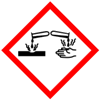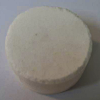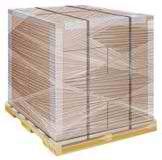SDS of Potassium peroxymonosulfate or Potassium monopersulphate or Potassium monopersulfate Manufacturers
CAS Number: 70693-62-8 or 10058-23-8
Potassium peroxymonosulfate or Potassium monopersulphate or Potassium monopersulfate Manufacturers.
Potassium Monopersulfate or Potassium Monopersulphate (or peroxymonopersulfate) Triple Salt SDS, Safety Data Sheet.
MSDS, Material Safety Data Sheet 05-Sept-22
1. Product Identification
Product Name/Synonyms: Potassium peroxymonosulfate triple salt or Potassium monopersulfate triple salt Potassium monopersulphate triple salt.
CAS Number: 70693-62-8
EINECS EC Number: 274-778-7
Molecular Weight: 614.76
Chemical Formula: 2KHSO5.KHSO4.K2SO4
Recommended usage: Industrial Manufacturing.
2. Hazards Identification
GHS, Globally Harmonized System Classification in accordance with 29 CFR 1910
Classification according to Regulation (EC) No 1272/2008
Acute toxicity, oral Category 4 - H302
Skin corrosion/irritation Category 1A, B, C - H314
Specific target organ toxicity (single exposure) Target Organs - Respiratory system Category 3 - H335
Labeling according to GHS & Regulation (EC) No 1272/2008
GHS Label Elements  Corrosive |
Signal Words: Danger
Hazard statements:
H272: May intensify fire; oxidizer.
H302: Harmful if swallowed.
H314: Causes severe skin burns and eye damage.
H335: May cause respiratory irritation.
Precautionary statements:
P210: Keep away from heat/sparks/open flames/hot surfaces – No smoking.
P220: Keep/Store away from clothing/…/combustible materials.
P221: Take any precaution to avoid mixing with combustibles.
P260: Do not breathe dust/fume/gas/mist/vapors/spray.
P261: Avoid breathing dust/fume/gas/mist/vapors/spray.
P264: Wash with plenty of water and soap thoroughly after handling.
P270: Do not eat, drink or smoke when using this product.
P280: Wear protective gloves/protective clothing/eye protection/face protection.
P281: Wear protective equipment for hands, eyes, face, and respiratory tract.
P330: Rinse mouth.
P301+330+331: IF SWALLOWED: Rinse mouth. Do NOT induce vomiting.
P301+312: IF SWALLOWED: Call a POISON CENTER or doctor/physician if you feel unwell.
P302+P352: IF ON SKIN: Wash with plenty of soap and water.
P303+361+353: IF ON SKIN (or hair): Remove/Take off immediately all contaminated clothing. Rinse skin with water/shower.
P304+340: IF INHALED: Remove victim to fresh air and keep at rest in a position comfortable for breathing.
P305+P351+P338: IF IN EYES: Rinse cautiously with water for several minutes. Remove contact lenses, if present and easy to do. Continue rinsing.
P370+378: In case of fire: Water can be used for extinction.
P312: Call a POISON CENTER or doctor/physician if you feel unwell.
P362: Take off contaminated clothing and wash before reuse.
P405: Store locked up.
P501: Dispose of contents/container in accordance with local/regional/national/international regulations.
3. Composition/Information on Ingredients
| Ingredient name | % |
CAS number |
Pentapotassium bis(peroxymonosulphate) bis(sulphate) |
≥90 |
70693-62-8 |
potassium hydrogensulphate |
≤5 |
7646-93-7 |
Dipotassium peroxodisulphate |
7727-21-1 |
|
Dipotassium disulphate |
≤5 |
7790-62-7 |
4. First Aid Measures
Inhalation: Remove to fresh air. If not breathing, give artificial respiration. If breathing is difficult, give oxygen. Get medical attention.
Ingestion: If swallowed, do not induce vomiting. Give large quantities of water. Never give anything by mouth to an unconscious person. Get medical attention immediately.
Skin Contact: In case of contact, immediately flush skin with plenty of water for at least 15 minutes while removing contaminated clothing and shoes. Cover the irritated skin with an emollient. Cold water may be used. Wash clothing & shoes before reuse. Get medical attention.
Eye Contact: Check for and remove any contact lenses. In case of contact, immediately flush eyes with plenty of water for at least 15 minutes. Cold water may be used. Get medical attention.
5. Fire Fighting Measures
Fire: It is not combustible, but substance is an oxidizer and its heat of reaction with reducing agents or combustibles may cause ignition. Heating which may intensify combustion in an existing fire.
Explosion: An explosion hazard when mixed with finely powdered organic matter, metal powder, or reducing agents. Avoid grinding or intense mixing.
Fire Extinguishing Media: Use any means suitable for extinguishing surrounding fire Water can be used.
Special Information: In the event of a fire, wear full protective clothing and NIOSH-approved self-contained breathing apparatus with full face piece operated in the pressure demand or other positive pressure mode. At high temperatures under fire conditions, it may produce toxic or irritating fumes. Fire-extinguishing work is done from the windward and the suitable fire-extinguishing method according to the surrounding situation is used. Uninvolved persons should evacuate to a safe place.
6. Accidental Release Measures
Personal precautions, protective equipment, environmental precautions, and emergency procedures: Avoid breathing dust/fumes/gas/mist/vapors/spray. Use individual protective equipment (waterproof boots, suitable protective clothing, safety glasses, etc.). Do not approach facing the wind. Do not touch the spilled material. Keep away from drains, surface and groundwater and soil.
Methods and materials used for containment Cleanup procedures and Storage: It is an oxidizing material. Stop leak if without risk. Avoid contact with a combustible material (wood, paper, oil, clothing...). Keep damp using water spray. Do not touch spilled material. Prevent entry into sewers. Eliminate all ignition sources. Do not touch or walk through spilled material.
7. Handling and Storage
Precautions for safe handling: Apply according to good manufacturing and industrial hygiene practices with proper ventilation. Wash thoroughly after handling. Do not drink, eat, or smoke while handling. Avoid contact with skin, eyes, and clothing. Use with adequate ventilation. Minimize dust generation and accumulation. Avoid breathing dust/fumes/gas/mist/vapors/spray. Keep container tightly closed. Avoid ingestion and inhalation. Use individual protective equipment (waterproof boots, suitable protective clothing, safety glasses, etc.).
Conditions for safe storage, including any incompatibilities: Store in cool, dry and ventilated area away from heat sources and protected from sunlight in tightly closed original container. Keep air contact to a minimum. Store protected from heat, sparks and ignition sources and incompatible materials. Avoid contact with skin and eyes. Avoid inhalation of dust/mist/vapor. Do not store with incompatible materials like reducing agents, organic material, sodium peroxide, water, and powdered metals, especially aluminum. Moisture must be avoided. Avoid storage on wood floors. Containers may be hazardous when empty.
8. Exposure Controls/Personal Protection
Airborne Exposure Limits:
TWA: 5 (mg/m3) from OSHA (PEL) [United States] Inhalation Respirable.
USA ACGIH TLV: TWA: 0.1 mg/m3.
Ventilation System: A system of local and/or general exhaust is recommended to keep employee exposures below the Airborne Exposure Limits.
Personal Respirators (NIOSH Approved): For conditions of use where exposure to dust or mist is apparent and engineering controls are not feasible, a particulate respirator (NIOSH type N95 or better filters) may be worn.
Skin Protection: Wear protective gloves and clean body-covering clothing.
Eye Protection: Use chemical safety goggles. Maintain eye wash fountain and quick-drench facilities in work area.
Other Control Measures: Maintain good housekeeping in work area. Handle in accordance with good industrial hygiene and safety practice. Wash hands after handling.
9. Physical and Chemical Properties
Appearance: Potassium peroxymonosulfate or Potassium Monosulfate is white crystals.
Odor: Odorless.
Odor threshold: Not available.
pH: 2.3 at 10g/1000 ml water @ 20C
Relative density: 1.98
Melting point/freezing point: 120C (248F) Decomposes.
Initial boiling point and boiling range: Not available.
Flash point: Not available.
Auto-ignition temperature: Not available.
Decomposition temperature: Not available.
Upper/lower flammability or explosive limits: Not available.
Vapor pressure: Not available.
Vapor density: Not available.
Evaporation rate: Not available.
Flammability (solid, gas): Not available.
Partition coefficient: n-octanol/water: Not available.
Solubility: 256 g/l000 ml water @ 20C
Viscosity: Not available.
10. Stability and Reactivity
Stability: Stable under ordinary conditions of use and storage. Stability decreases in the presence of moisture.
Hazardous Decomposition Products: Decomposed by moisture to form oxygen and ozone.
Hazardous Polymerization: Will not occur.
Incompatibilities: Reducing agents, organic material, sodium peroxide, water and powdered metals especially aluminum. Heat and Strong bases & Acids must be avoided.
Conditions to Avoid: Moisture, combustible materials, and incompatibles.
11. Toxicological Information
| Product/ingredient name | Dose |
Test |
Potassium monopersulphate, LD50 Oral, Rat - Male, Female |
500 mg/kg |
OECD 423 Acute Oral toxicity – Acute Toxic Class Method |
Potassium monopersulphate, LD50 Dermal, Rat - Male, Female |
>5000 mg/kg Extrapolation as per Regulation (EC) No. 440/2008 |
402 Acute Dermal Toxicity |
Potassium monopersulphate, LC50 Inhalation Dusts and Mists, Rat - Male, Female |
>5 mg/l for 4 hours Expert judgement Dosage caused no mortality |
OECD 403 Acute Inhalation Toxicity |
Carcinogenic Effects: None of the components present in this material at concentrations equal to or greater than 0.1 % are listed by IARC, NIP, OSHA or ACGIH as a Carcinogen.
Mutagenic Effects: Not available.
Teratogenic Effects: Not available.
Developmental Toxicity: Not available.
12. Ecological Information
| Product name | Test |
Result |
Pentapotassium bis |
OECD 202 Daphnia Magna sp. Acute Immobilization Test |
Acute EC50 3.5 mg/l Fresh water, Daphnia Magna, 48 hours. |
Pentapotassium bis |
OECD 203 Fish, Oncorhynchus Mykiss Acute Toxicity Test |
Acute LC50 53 mg/l Fresh water, Oncorhynchus Mykiss, 96 hours. |
Dipotassium |
Acute EC50 120 mg/l, Daphnia – Daphnia Magna, 48 hours. |
|
Dipotassium |
Acute LC50 76.3 mg/l, Fish – Oncorhynchus |
|
Dipotassium disulphate |
Acute EC50 720 mg/l Readacross from CAS # 7778-80-5, Fresh water, Daphnia Magna, 48 hours. |
|
Dipotassium disulphate |
Acute LC50 680 mg/l Readacross from CAS # 7778-80-5, Fresh water, Fish – Pimephales |
Mobility: No information available. Likely to be mobile due to water solubility.
Bioaccumulation/ Accumulation: No information available.
Results of PBT and vPvB assessment: No data available for assessment.
13. Disposal Considerations
Whatever cannot be saved for recovery should be handled as hazardous waste and sent to an approved waste facility.
14. Transport Information
DOT USA, TDG Canada & ADR/RID Europe
UN-Number: 3260 Class: 8, Packing group: II
Proper shipping name: Corrosive solids, n.o.s. (Potassium hydrogenperoxomonosulphate)
IMDG/IMO & IATA
UN-Number: 3260 Class: 8, Packing group: II
Proper shipping name: Corrosive solids, n.o.s. (Potassium hydrogenperoxomonosulphate)
15. Regulatory Information
USA FEDERAL REGULATIONS:
SARA 311/312: See section 2.
SARA (313) Chemicals: No
Section 16 - Additional Information
Disclaimer:
**************************
Our company provides this MSDS sheet in good faith but makes no representation as to its comprehensiveness or accuracy. This SDS sheet is intended only as a guide to the appropriate precautionary handling of the material by a properly trained person using this product. The above information has been compiled from various sources and has the possibility of discrepancy and being out-dated information. Individuals receiving the information must exercise their independent judgment and do further search in determining its appropriateness for a particular purpose. In no case shall our company be liable to loss or damages by the product user.
**************************


Potassium peroxymonosulphate or Potassium monopersulfate or Potassium monopersulfate Manufacturers:
Muby Chemicals & Associated Cos
BANDEALI BUILDING, CHINCHBUNDER, MUMBAI 400009, INDIA.
TEL: 91-22-23728264. Gujarat & Mumbai India.
info(At the Rate i.e. @)mubychem(dot)com

Copyright and Usual Disclaimer is Applicable
Last updated
7-may-25

Exports to USA UAE Europe South Africa Tanzania Kenya Uganda Egypt Nigeria Turkey Brazil Chile Argentina Dubai Cameroon Guatemala Mexico etc.
Barter
They who love thee on this earth, keep calling on thee and chanting thy beads
Lest thou forgetest.
They assign the credit of their hard work to your blessings
They keep you amused.
They come to thy temple with baskets of fruits, as if you were a glutton
They deny the same to their children.
They offer you milk for a bath and burn the ghee
They hardly understand the meaning of it.
They bring gold and diamonds. They come with beating of drums
They love to advertise their offerings.
They offer you a small bribe as advance for booty, called lottery
They love to dream.
I do not bow down at your door
I do not bargain for booty
Your promise of the heaven does not lure me
Your hell-fire does not scare me
I do not even know the proper method of prayer
I do not offer any thing to you
Ages have gone by and I have not seen you my lord
Yet my love for you keeps waiting for you.
